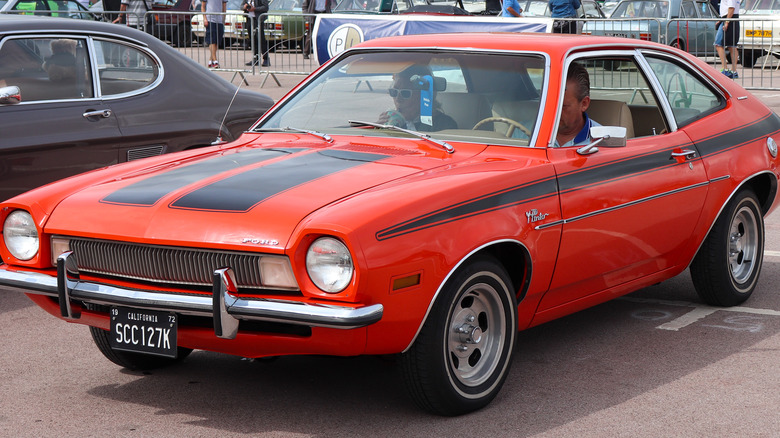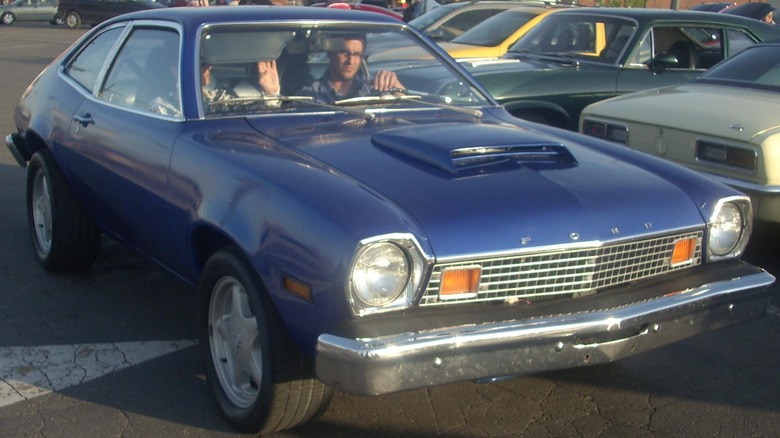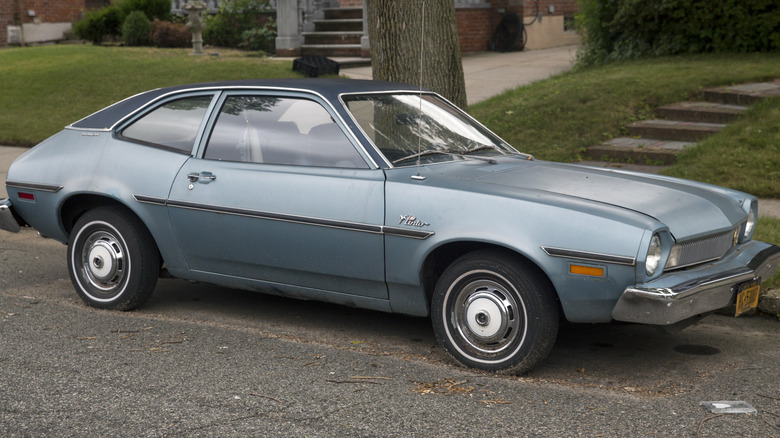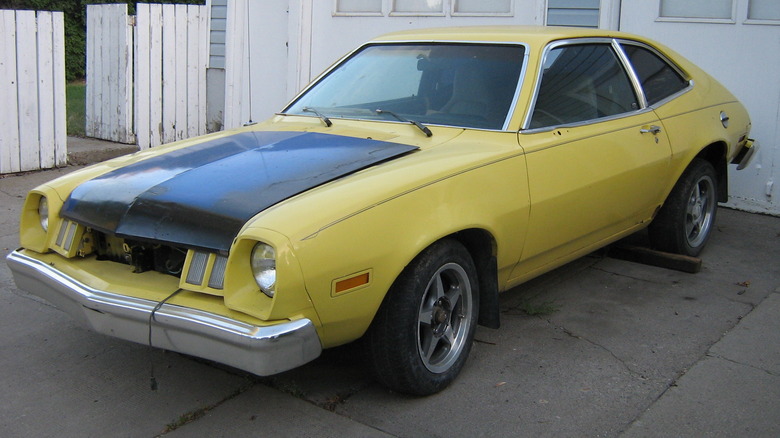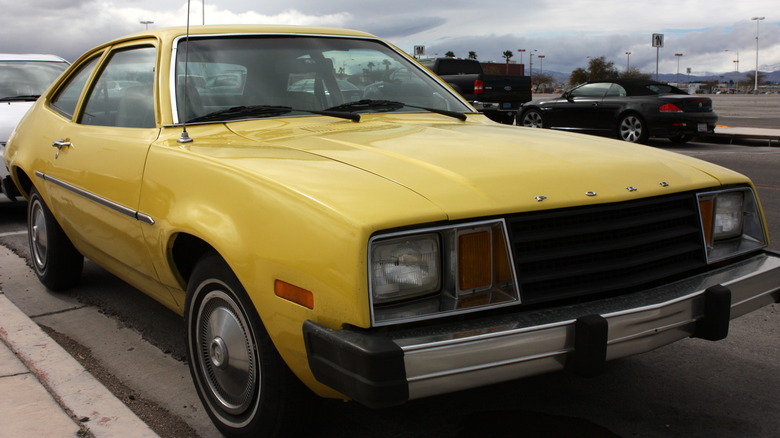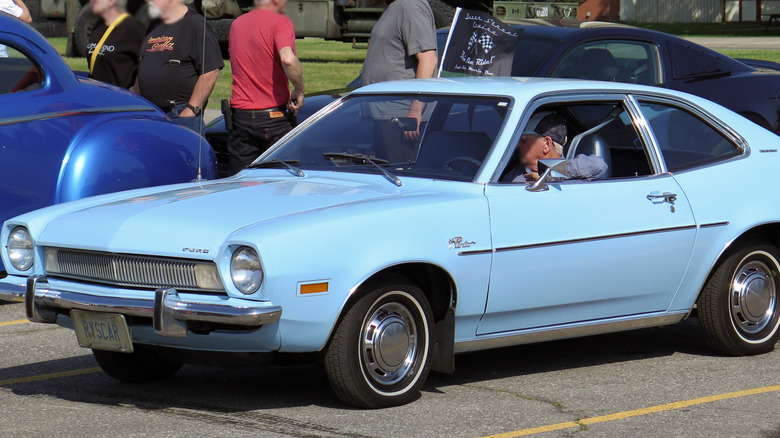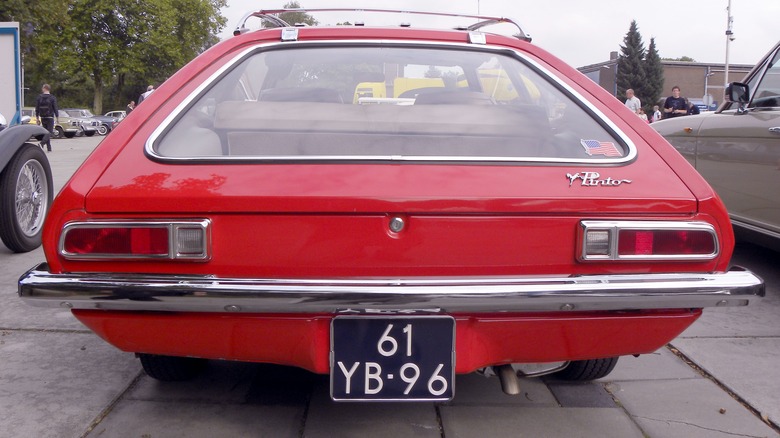What Ever Happened To The Ford Pinto?
In the 1984 parody film "Top Secret!" — follow up to the comedy classic "Airplane!" from David Zucker, Jerry Zucker, and Jim Abrahams — there is a large, gag-filled action set piece as the group of heroes fend off German soldiers. One of the gags is a German truck that comes to a slow crawl after the driver slams down on the brake. However, right in front of the truck is a Ford Pinto. The truck lightly taps the rear of the car, hitting it at a speed that wouldn't even cause a scratch. However, instead, the Ford Pinto explodes, causing the German truck to burst into a ball of flames as well.
People seeing "Top Secret!" today might have absolutely no idea why that gag is in the movie. Back in 1984, though, the legacy of the Ford Pinto was fresh, having only been out of the market for four years.
Nearly 45 years since being discontinued, some people may not know how or why the Ford Pinto went from being an exciting vehicular prospect to an utter punchline throughout the 1970s. Let's look back at the history of the Pinto and see how it became one of the most controversial cars of all time and why it still has its defenders today.
[Featured image by Vauxford via Wikimedia Commons | Cropped and scaled | CC BY-SA 4.0]
What was the Ford Pinto?
Back in the late 1960s and early 1970s, subcompact cars in the United States were rare. Until AMC debuted the Gremlin in 1970 compact cars didn't make any sort of headway in America. After all, this was the heyday of the muscle and pony cars with hulking V8 engines, and a car this small couldn't handle that kind of power and weight. After the debut of the Gremlin, the Ford Pinto hit the market for the 1971 model year.
This vehicle was designed with two major factors in mind. The first was for it to be a light-weight vehicle, and in that effort, Ford made a car that weighed just 2,015 lbs. at its most basic. This was when the Pinto was outfitted with the standard issue 1.6L Kent I4 engine that was only able to produce 76 hp and 96 lb.-ft. of torque. Again, this was not a car designed with power in mind.
That weight translated to an incredibly affordable vehicle. That base package for the Pinto had a starting price of just $1,919, which would be a little over $15,000 today. Considering that Ford's current least expensive vehicle is the Ford Maverick, which has a $23,920 starting price, the Pinto was an incredible deal for people in need of a budget-friendly automobile. For comparison, Chevrolet introduced its subcompact car, the Vega, just one day before the Pinto, and it cost $2,090.
[Featured image by Bull-Doser via Wikimedia Commons | Cropped and scaled | Public Domain]
It saw strong early sales
The Ford Pinto received decent nods from the likes of Consumer Reports and Car and Driver, but it didn't receive universal critical acclaim, which was perhaps expected considering the market that this car was designed to corner. The somewhat mixed reaction to the Pinto certainly didn't affect it when it came to sales.
It took about five months for the Pinto to sell 100,000 units, and by the time the 1971 production year had come to an end, Ford had managed to sell over 350,000 Pintos. In the first year, Ford offered the car in two different configurations, a sedan and a Runabout hatchback. When 1972 production began, it decided to add to that lineup a station wagon model as well. This helped increase sales to over 480,000 units that year, which would remain steady in 1973. The Ford Pinto hit its sales high in the 1974 model year, topping over 544,000 units across the three model configurations.
These weren't numbers that had the Ford Pinto topping the list of the best-selling vehicles of the year, but they were strong enough to be beating out competitors like the Chevrolet Vega. It was popular enough that Lincoln-Mercury began selling a rebadged Pinto called the Bobcat in Canada in 1974, expanding to the United States the following year. The Pinto was hot, and then it wasn't.
[Featured image by Mr.choppers via Wikimedia Commons | Cropped and scaled | CC BY-SA 3.0]
The major Ford Pinto design flaw
If the popularity of the Ford Pinto continued to rise, then how could it have become something to be avoided so quickly? Well, that all has to do with the placement of the car's fuel tank and the design surrounding it. Now, it is not unusual for a vehicle's fuel tank to be in the rear, with the filled on the left side. You have to actively search out cars that don't fit that basic description. What was unusual about the design of the Pinto, though, was that the fuel tank was placed directly behind the rear axle.
The rear of the Pinto was not heavily reinforced, which would be bad enough on its own if one were to get into a collision. With the fuel tank being behind the rear axle, that also left the tank vulnerable to being punctured. You pair those two things together, and you ran the risk of leaking gasoline all over the place even if you were hit in the rear and a moderate-to-slow speed, let alone with an abundance of force.
This meant that the Ford Pinto had a reputation for catching fire in a wreck, no matter the speed of the collision. This resulted in incredibly serious burns and even several deaths in car accidents.
[Featured image by dave_7 via Wikimedia Commons | Cropped and scaled | CC BY-SA 2.0]
Recalls, investigations, and lawsuits
Reports of Pintos bursting into flames circulated in 1973, the same year the infamous cost-benefit analyses report from Ford was created. Some saw it as the company prioritizing saving money over saving lives. The following year, the National Highway Traffic Safety Administration was urged to put out a recall on the Pinto due to these fires, which would force Ford to change how it designed the vehicle's fuel system. However, the NHTSA chose not to, letting the Pinto continue on.
Mark Dowie published a piece in Mother Jones magazine entitled "Pinto Madness" that exposed the negligence of both Ford and the NHTSA when it came to the dangers of the Pinto. The Center for Auto Safety, with co-founder Ralph Nader, petitioned for the NHTSA recall, leading a vocal crusade against the car. A press conference was held by the Center and Mother Jones in August of that year, and the very next day, the NHTSA opened up an investigation after the public pressure. Nine months later, it concluded that the fuel system was indeed defective and needed to be recalled. Officially, 27 people died as a result of Ford Pinto fires. Ultimately, 117 lawsuits were brought against Ford relating to deaths, burns, and injuries relating to this defect.
[Featured image by Michael Dorausch via Wikimedia Commons | Cropped and scaled | CC BY-SA 2.0]
How the Pinto ended
Once the word got out about Ford Pintos bursting into flames, the sales for the subcompact car nose-dived. As mentioned before, 1974 saw the sales of the Pinto blow past the half a million units mark. That was also the last year the public went without knowing about the fires, either from the news or pure hearsay. The following year, Ford sold fewer than half of the number of Pintos as the previous year, under 224,000. The NHTSA was still three years away from issuing a recall on the car, but it didn't matter. The word was out, and there wasn't much Ford could do to stop it.
When the 1978 model year rolled around, which was when the recall was issued, sales dropped below 200,000 units for the first time, and was never able to recover. That year was also when two major lawsuits were filed against Ford, resulting in the Grimshaw v. Ford Motor Co. and Indiana v. Ford Motor Co. cases, which have shaped how the courts handle corporate liability and negligence, as well as how risk analysis assessments are utilized. Ford was forced to pay hundreds of millions of dollars.
Ford let the Pinto limp along through the 1980 model year, but after that, it discontinued the vehicle. The company would change focus to the new model for 1981, the Ford Escort. That would prove to have a much longer life, lasting until the 2003 model year.
[Featured image by Elise240SX via Wikimedia Commons | Cropped and scaled | CC BY-SA 4.0]
The legacy of the Ford Pinto
Once the Ford Pinto was taken off the market, it was not exactly missed. It had earned a reputation for being a deathtrap on wheels. It almost doesn't matter that studies on overall deaths by subcompact cars at the time, such as "The Myth of the ford Pinto Case" by Gary T. Schwartz in 1991, have shown that the Pinto was not really any worse on the whole than any other contemporary vehicle. Granted, the fuel system was a problem, but once that was fixed by Ford, the Pinto was a perfectly fine vehicle to drive. But its reputation had just been too tainted to recover.
There are still fans of the Ford Pinto today, and there is an annual event called the Pinto Stampede where enthusiasts of the subcompact car get together to indulge in their love of driving the car. That being said, it is still a relatively small group of people.
When a Ford Pinto gets mentioned now, it has become shorthand for a poorly built, dangerous vehicle. This could be either as a warning or as a punchline. No other car could have made for such an effective gag in "Top Secret!" than the Ford Pinto.
[Featured image by Joost J. Bakker via Wikimedia Commons | Cropped and scaled | CC BY 2.0]
